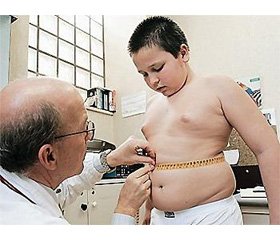Международный эндокринологический журнал 8 (64) 2014
Вернуться к номеру
Anthropometric standards and clinical features of obesity in children
Авторы: Sorokman T.V. - Bukovinian state medical university
Рубрики: Эндокринология
Разделы: Клинические исследования
Версия для печати
Obesity in childhood is a predictor of cardiovascular disease in adulthood. 20% of obese children have at least one of the cardiovascular risk factors such as hypercholesterolemia, hyperinsulinemia, hypertriglyceridemia or hypertension.
Material and methods. There were examined 325 children aged 10 to 18 years from different areas of residence of Chernivtsy region. The control group consisted of 80 healthy children of the same age. Methods of examination included medical history, anthropometry (height, weight, body mass index calculation – BMI, waist circumference – WC, hip circumference – HC value calculation WC/HC), laboratory and instrumental examination. Physical development was assessed by cantle tables.
The processing of the results was performed using methods of medical statistics and the application package Statistica 7,0, MS Excel.
Results. Among the surveyed group of children with overweight obese boys prevailed, whose number was 185 persons (60%), while girls were 140 (40%) (p<0,001). Gender analysis of anthropometric indices showed significantly higher indices of growth increase (P), body weight (BW), WC and HS, and their ratio among boys (p<0,05). The dependence of the frequency of EBW and obesity in children depending on place of residence (60% of children with obesity and EBW lived in the city). In 45 (15,7%) children had excessive body weight in both parents, 80 (28,1%) – only one (often the mother than the father). Relatives who suffer from obesity were in 86,9% of patients.
Studying the history of life possible complications set in the perinatal period, 85 (30,2%) children. Most were found toxicosis of pregnancy (26,1%), threatened abortion (19,6%), preterm birth (17,3%). From concomitant diseases often registered gastro-intestinal tract (47,3%), vegetative-vascular dysfunction (23,1%), endocrine system (23,1%), rhynopharengeal pathology (21,3%).
The main endocrine pathology that was diagnosed in children was diffuse euthyroid goiter – 15,6%. Youth gynecomastia occurred in 10,8% of boys, menstrual dysfunction registered in 14,2% of girls. Draws attention to the high frequency of detection of pathologies of vision, including myopia of different stage of severity was diagnosed in 56 children (20,7%), myopic astigmatism complex – surveyed in 15 (5,2%). Two-thirds of children by questioning indicated the following complaints: headache, increased fatigue, dizziness, increased sweating; every second child had complaints on periodical increase of temperature to subfebrile numbers, frequent colds, and poor tolerance oily and fried foods. In 21% of children in the main group survey showed teenage acne, increased skin dryness, red dermographism, in 33,6% – stria.
Cardiac arrhythmia was diagnosed in 21,1% of cases, conductivity – in 35,1% (non-permanent atrial extrasystoles single); early signs of ventricular repolarization – in 14,0% of cases. Left ventricular hypertrophy was diagnosed in 12,6% of cases among children with consistently high blood pressure. In 36,9% of children blood pressure appropriate to high normal blood pressure ranges from 90 to 95 percentile. In 64,9% of children blood pressure was higher than 95 percentile, that can be estimated as hypertension.
Analysis of anamnesis allowed to find out a debut syndrome of hypertension in children with overweight and obesity. There was established that the first episode of high blood pressure accounted for age (13,8 ± 1,4) years, i.e. puberty. Gender differences in the time of onset of hypertension syndrome were not diagnosed. In girls, it accounted for age (12,8 ± 0,5) years, for boys – (14,5 ± 1,5) years (p>0,05).
Conclusions.
1. Overweight and obesity is more common in residents, boys of age group 15-18 years and girls aged 12-15.
2. The clinical course of excessive body weight and obesity in prepubertal children and pubertal age is a combination of many nosology, which leads to a large number and variety of clinical symptoms.
1. Аверьянов А.П. Ожирение у детей и подростков: клинико-метаболические особенности, лечение, прогноз и профилактика осложнений / А.П. Аверьянов // Міжнародний ендокринологічний журнал. — 2009. — № 4(22). — С. 90-98.
2. Бугрова С.А. Висцеральное ожирение — ключевое звено метаболического синдрома / С.А. Бугрова // Міжнародний ендокринологічний журнал. — 2009. — № 2(20). — С. 82-84.
3. Наказ Міністерства охорони здоров’я України від 27.04.06 № 254 в редакції наказу МОЗ України від 03.02.2009 № 55 «Про затвердження протоколів лікування дітей з ендокринними захворюваннями» [Електронний ресурс]. – Режим доступу до інф. : http://www.uazakon.com/big/text363/pg1.htm.
4. Павлишин Г. А. Епідеміологічна ситуація щодо надмірної маси тіла, ожиріння та артеріальної гіпертензії у дітей м. Тернополя / Г. А. Павлишин, К. В. Левандовська // Вісник наукових досліджень. – 2012. – № 4 (69). – С. 117–119.
5. Проблема ожирения в Европейском регионе Всемирной организации здравоохранения и стратегии ее решения // Ліки України. – 2010. – № 7 (143). – С. 36–40.
6. Clinical guidelines on the identification, evaluation, and treatment of overweight and obesity in adults—the evidence report / National Institutes of Health, National Heart, Lung, and Blood Institute // Obesity Research. — 1998. — Vol. 6, Suppl. 2. — P. 51S-209S.
7.IDF consensus definition of the metabolic syndrome in children and adolescents / S. G. Alberti, P. Zimmet, F. Kaufman [et al.]. – International Diabetes Federation, 2007. – 24 p.
8. Obesity and overweight / Fact sheet № 311. — Geneva: World Health Organization, 2006. — 3 p.
9. WHO obesity: preventing and managing the global epidemic. WHO Technical report Series number 894. Geneva: WHO, 2000.

